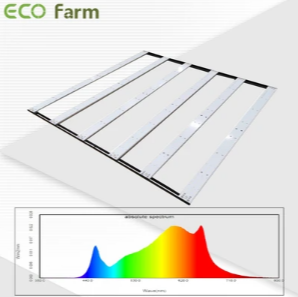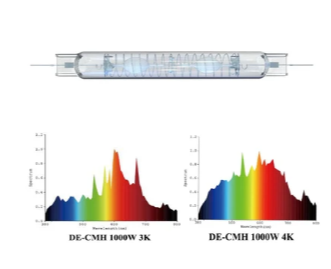Grow lights have evolved from heavy magnetic, in-efficient ballasts and bulky reflectors to ultra-efficient dimmable and spectrum tunable Light Emitting Diodes (LED) and Ceramic Metal Halide (CMH) all-in-one fixtures. The modern hobby and commercial cultivator now have the power to dial in spectrums specific to the plant strain they are growing. LED’s offer the tunability to go from a vegetative blue spectrum to a flowering red spectrum with a turn of a knob. CMH’s closely mimic the sun, provide the highest gram per watt, and even provide the coveted good UV wavelengths that fend off mold and mildew as well stimulate plant vigor and greater resin and terpene production. Choosing which technology is right for you depends on the size of your grow, how long you will be growing in the space, and your allocated budget.
The anticipated duration of your cultivation project is one of the most important factors to consider. Choose LED grow lightif you plan on keeping the fixtures for more than 5 years as the high upfront initial cost of LED fixtures will be amortized over a longer period of time. LED bulbs last 50,000 hours compared to 20,000 for CMH. If you are planning for obsolescence and want the greatest yield ROI within 1-2-year time frame, choose CMH. And even if you keep your grow space past 5 years, don’t worry, CMH’s provide a greater gram per watt due to their higher PPF and canopy penetration.
Let’s talk about the size of your grow. Because of the lack of overall canopy penetration, you will need to keep your LED lights 12-18” above your canopy. This could be a good thing if your ceiling height is less than 8ft and really need to factor in heat management. If you have a larger and taller space, using CMH technology is a better choice. Increased ceiling height allows for better heat management, better air-flow capability and more even light coverage for fuller and taller flower strains. LED lights put off very little heat and this can be good or bad depending on the size of your grow space and the climate at your facility location. How insulated your space is during winter months is crucial if you are operating in colder climates. Due to the lower heat output of LED’s, heat may need to be added to the grow room in colder months which will increase costs. CMH fixtures put off more heat than LED’s, but less heat than their HPS counterparts. This heat can be utilized to achieve the ideal temperature for your growing methodology, for example, if you are using CO2 injection.
CMH vs LED: Adjusting Light Spectrum
Also, CMH grow light systems have a removable bulbs. You can replace the bulb with high quality grow bulbs that have a slightly redder (3100K) or bluer spectrum (4000K).Many LED grow lights allow you to “adjust” the spectrum. Basically, this just means turning off the red or blue diodes on the grow light. Doing this significantly reduces light output from the grow light system.In our CMH vs LED face off, CMH grow lights offer an adjustable spectrum with full intensity just by switching out the lamp. And LEDs can’t do that yet.
LED grow light over seedlings
LED grow lights are great in small spaces with smaller plants.
Grow Light Intensity
Grow light intensity is a really important factor to consider and also really confusing. I’ll go a little into the details, but the basic point is CMH grow lights put out way more intense light than LED grow lights ever can.The intensity directly relates to canopy penetration.Here’s the idea, there’s physical law about light called the “Inverse Square Law”. It states that the intensity of light is inversely proportional to the square of the distance from the light source.Sure, reflectors and multiple light sources change things a bit, but it doesn’t change the fact that the light intensity drops steadily.
Canopy Penetration
More canopy penetration generally translates into denser, bigger buds.CMH grow lights can penetrate 18 to 24 inches into the canopy when they are hanging three feet above. Where LED grow lights can only penetrate 6 inches deep, and must be suspended 6 inches above the canopy.It also means that since the LED light is so weak to start off with, it won’t penetrate into the canopy. Even if you hang it six inches above the canopy. And you’ll be adjusting the hanging height of the lights really often.But since CMH grow lights are so intense to start off with, the light will penetrate much deeper through the canopy. This means you’ll get a higher gram per watt with CMH grow lights over LED grow lights.And you probably won’t need to adjust the light height as often.The only case where LEDs are a better option here are low ceilings, and LEDs work great for under canopy lighting. I believe if you’re working with ceilings less than 8 ft in height, it’s a good idea to use LEDs.
If you haven’t already thought about how long you’ll use your lights, you may want to consider it now.I’ve helped lots of growers over the years. Most of the time people keep their grow lights for two or three years before swapping them out. Warranties expire, new technology comes out, the grow lights themselves eventually don’t perform as well as they did when they were new.That said, you can replace the CMH grow bulb every six months to a year and it will perform like new. Assuming you’re cleaning your reflector too!LEDs are supposed to last eight to nine years before their “usable life” is over. But often times a diode here or there will fail. And in that time the system itself will become outdated. Even with a long lifespan, LEDs light output will steadily fade over that time period. Nothing lasts forever.The math on a long term investment looks good on paper for LEDs, but it doesn’t reflect most real world scenarios.
Cultivation Size
Let’s talk about the size of your grow. Because of the lack of overall canopy penetration, you will need to keep your LED lights 6 to 18” above your canopy.This could be a good thing if your ceiling height is less than eight feet and you really need to be careful with your heat management.But, like I mentioned above, if you have a larger and taller space, using Ceramic Metal Halide Grow Lights is a better choice.An increased ceiling height allows for better heat management, better air-flow capability and more even light coverage for fuller and taller flower strains.Then there is technology like DimLux Half Force, that turns the lights on and off, every three hours, in a checkerboard pattern throughout the grow room. This system works well because the lights send out so much light that they overlap. Even when every other light is turned off. Basically, there is enough light intensity for the plants to grow at near its maximum potential. Regardless if the light directly above them is only on half the day.LEDs cannot do this. They are so much close to the canopy, and the LED light output lacks intensity. LED grow lights are also unidirectional, so the light doesn’t spread out like a CMH grow light can. So all the LEDs must be on all on at the same time.
Environmental Control
Here’s where LEDs really shine. They don’t put out as much heat as a CMH grow light.That means you’ll use less air conditioning to cool a grow room filled with LEDs than the same one covered by Ceramic Metal Halides.The verdict on environmental control isn’t so clear if you use DimLux Half Force. This is a major amount of energy saved. The lights are only on half the time. So both the grow lights and the air conditioners cooling the room are working much less.
Investment Cost and Budget
Finally, everyone’s favorite factor to consider, BUDGET!The initial cost of an LED is 2 to 4 times the cost of a comparable CMH fixture. LED fixtures, especially the ones that include the UV spectrum, are very expensive in terms of up-front cost.CMH grow lights are much more affordable in comparison.When it comes to power consumption and the power bill, LED’s only save the grower about 15% on the power bill compared to CMH fixtures.However, the LED grower will use less power for cooling, but that savings depends on other factors in the grow space.The additional cost a CMH grower will realize is replacing bulbs. You will be buying replacement CMH bulbs every twelve months of use.Additionally, it’s recommended that you change between the 4100K CMH bulbs in the vegetative phase to the 3100K CMH bulbs for flowering.So you will probably want to account for a little added cost of the extra bulbs when you’re using CMH technology. But you will optimize your light cycles and extend the timeframe to replace bulbs.
ECO Farm ECOY 600W Movable LED Grow Light Bar with Samsung LM301H Chip

Pros:
Certified with EC, ROHS, and UL listed
Uses PWM dimming lights
Provides an extra-large footprint that promotes better harvests
Allows you to fully adjust its spectrum to match the needs of your flowers and vegetables
Cons:
The deep penetration of spectrum is not that efficient for some plants
The fan is a little bit noisy
ECO Farm CMH 630W/1000W Double Ended Grow Light Fixture

Pros
All-in-one construction — ballast is built into the hood, making this kit much more compact than others
Bulb hangs vertically — more even light spread than horizontal bulb
Huge amount of light — given the 315w consumption, the bulb gives you a huge 33,000 lumen intensity
Long lifespan — the high quality bulb is rated for 20,000 hours and retains 85% of its PPF output in that time
Square wave ballast — no issues with RF interference and a much more steady stream of light
Low heat — this light does not need to be ventilated
Free ratchet hangers — a free set of ratchet hangers is included
Cons
High price — higher price than competing lights, but, as usual, you do get what you pay for
Final Thoughts
Obviously, you’re comparing CMH vs LED. Like I wrote above, both LEDs and CMH grow lights are effective at growing plants. CMH grow lights are great for commercial cultivations and hobbyists with enough space. They produce bigger denser buds, and they offer a rich list of options. On the other hand, LEDs are perfect for hobbyists with smaller spaces like grow tents. And they’re great for people growing in spaces with lower ceilings. Also, LEDs are great for under canopy lighting.